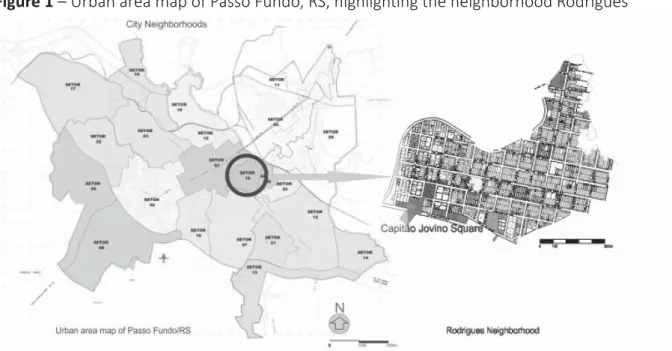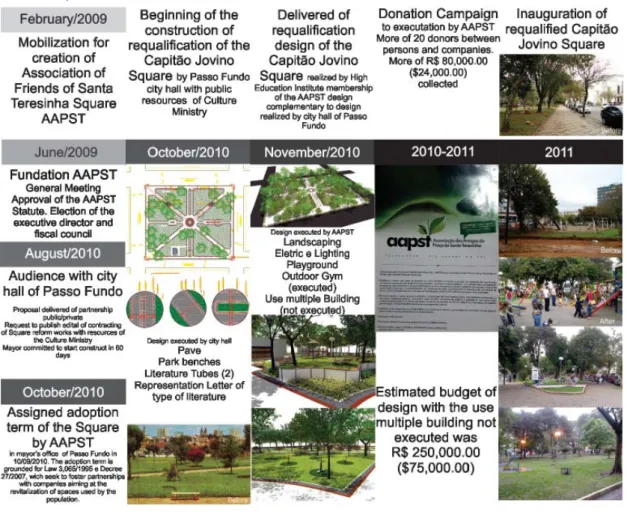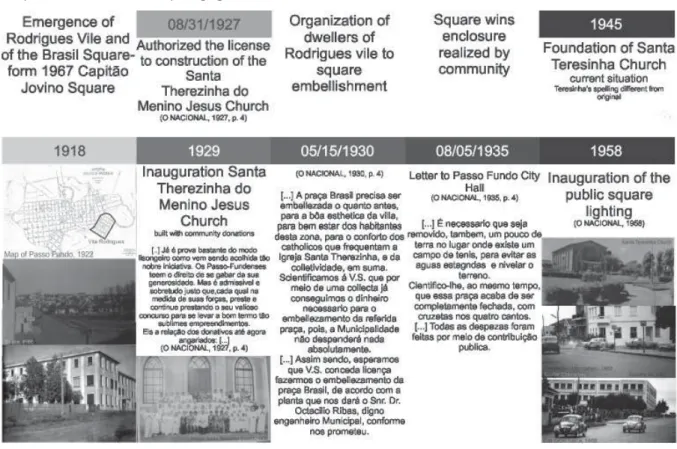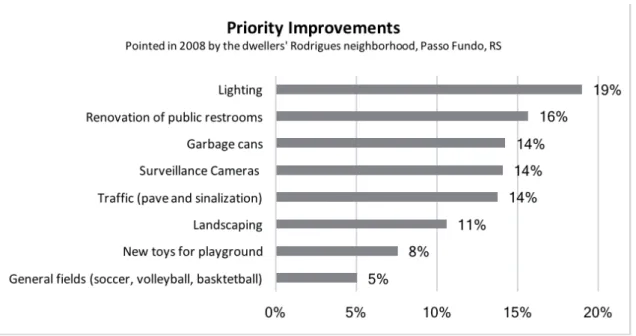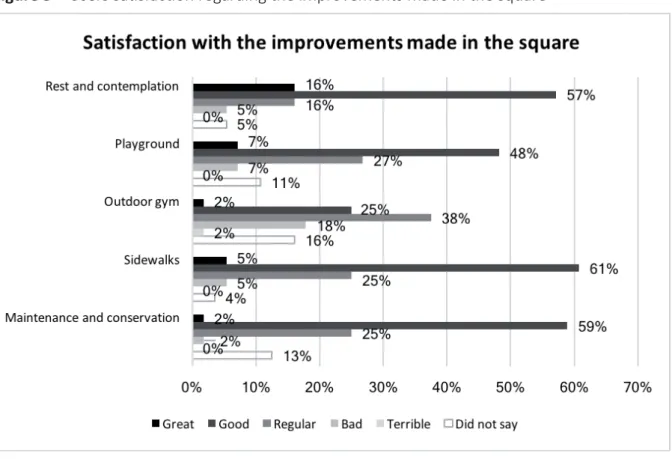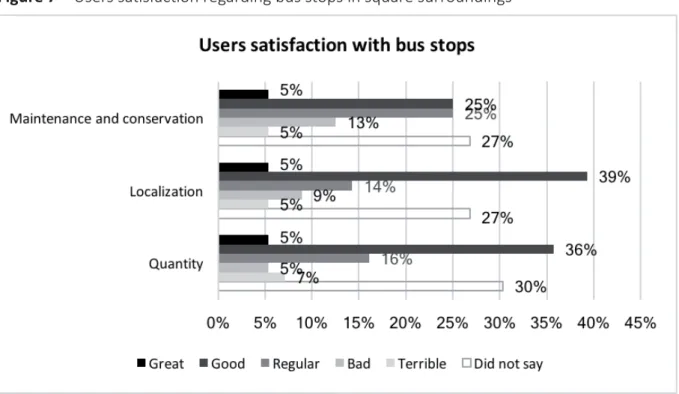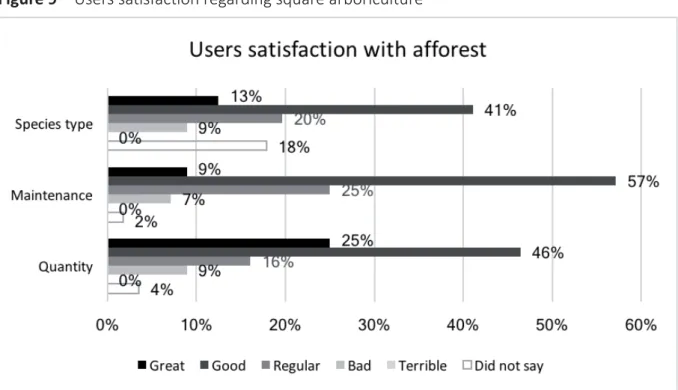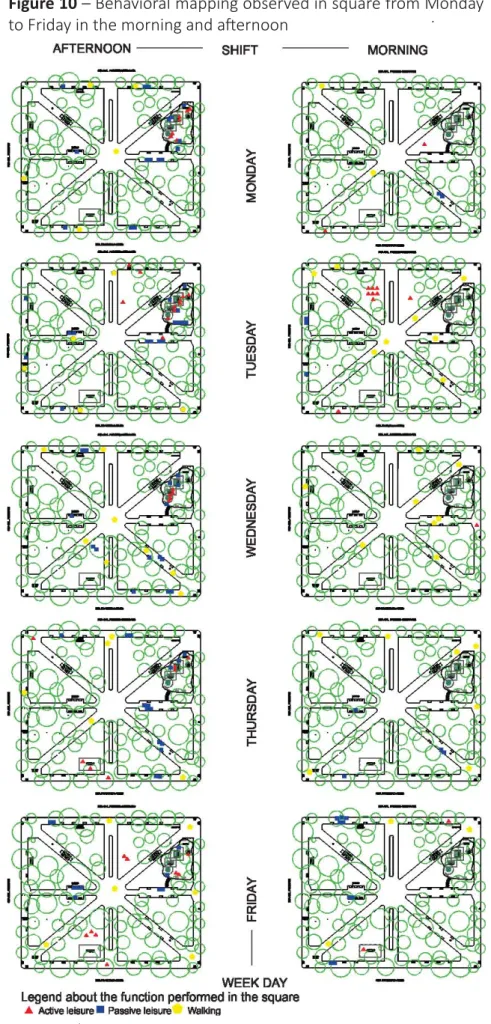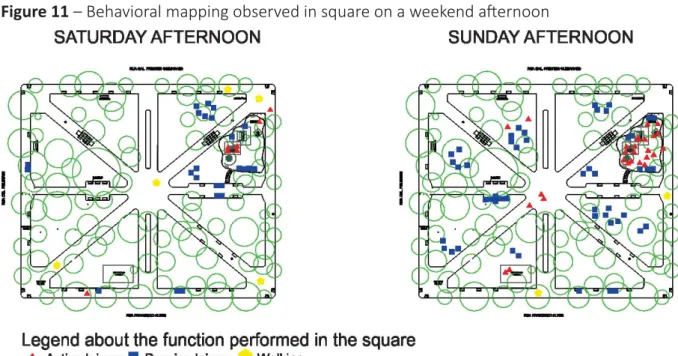Planejamento urbano contemporâneo: importância e consequências da
par
Ɵ
cipação dos cidadãos nos processos e decisões sobre o espaço urbano
Plani
fi
ca
Ɵ
on urbaine contemporaine: l’importance et les conséquences
de la par
Ɵ
cipa
Ɵ
on citoyenne dans les processus de décisions concernant
‘l’espace urbain
La plani
fi
cación urbana contemporánea: la importancia y las consecuencias
de la par
Ɵ
cipación ciudadana en los procesos de toma de decisiones sobre el
espacio urbano
Andréa Quadrado Mussi1
Recebido em 10/01/2018; revisado e aprovado em 25/03/2018; aceito em 13/04/2018 DOI: h p://dx.doi.org/10.20435/inter.v19i4.1805
Abstract: This paper contemplates on the importance of empowering local communi es to develop urban interven ons. One example of such importance is observed on the revitaliza on of a square of Passo Fundo, RS, Brazil, conducted through a public/private partnership. A survey of user sa sfac on and behavior presents the appropria on of the square. Planning, design and urban management ac ons performed throughout a period of eight years boosted crucial changes in the neighborhood urban dynamic.
Keywords: contemporary urban planning; empowerment of communi es; urban design; urban percep on; behavioral mapping.
Resumo: Este ar go refl ete sobre a importância do empoderamento de comunidades locais para alavancar
intervenções urbanas como a da praça de um bairro de Passo Fundo, RS, Brasil, realizada por intermédio de parceria público/privada. A pesquisa de sa sfação e comportamental dos usuários mostram a apropriação da praça. As ações de planejamento, projeto e gestão urbana realizadas num período de 8 anos impulsionaram mudanças cruciais na dinâmica urbana do bairro.
Palavras-chave: planejamento urbano contemporâneo; empoderamento de comunidades; projeto urbano; percepção urbana; mapa comportamental.
Résumé: Cet ar cle refl ète l’importance de l’émancipa on des communautés locales afi n de faire avancer
des interven ons urbaines telles que celle d’une place de quar er dans la ville de Passo Fundo, RS, Brésil, réalisée par un partenariat public-privé. La recherche comportementale et de sa sfac on montrent tous les deux l’appropria on de la place par les usagers. Les ac ons de la planifi ca on, de la concep on et de
la ges on urbaine menées sur une période de huit ans ont développé des changements cruciaux dans la dynamique urbaine du quar er.
Mots-clés: urbanisme contemporain; l’émancipa on des communautés; design urbain; percep on urbaine; cartographie comportementale.
Resumen: Este documento conduce a refl exiones sobre la importancia de empoderar a las comunidades
locales para aprovechar las intervenciones urbanas, como la plaza de un barrio de Passo Fundo, RS, Brasil, realizada a través de una asociación público / privado. La encuesta de sa sfacción del usuario y comportamiento presenta la apropiación del plaza. La planifi cación de la acción, el diseño y la ges ón urbana
tomado durante un período de ocho años impulsó cambios cruciales en la dinámica urbana del barrio.
Palabras clave: urbanismo contemporáneo; empoderamiento de las comunidades; diseño urbano; percepción urbana; mapa de comportamiento.
1 Faculdade Meridional (IMED), Passo Fundo, Rio Grande do Sul, Brasil.
Es
te é um ar
go public
ado em acesso abert
o (Open Access) sob a licenç
a Cr
ea
v
e Commons A
ribu
on, que permit
e
uso
, dis
tribuiç
ão e r
epr
oduç
ão em qualquer meio
, sem r
es
triç
ões desde que o tr
abalho original seja c
1 THE NECESSARY PERFORMANCE PERPETUATION OF SOCIAL ACTORS IN URBAN DYNAMIC QUALIFICATION
One of the challenges of contemporary urban planning is to perpetuate the performance
that social actors have been playing in the qualifi ca on and produc on of urban space. Especially
those organized into associa ons that include inhabitants, companies and ins tu ons (religious, higher educa on etc.) of a par cular neighborhood.
The required challenges to qualify the urban spaces and energize the city are so many that
isolated eff ort of public power is not enough. Thus, it is important to join eff orts and to seek joint
ac ons by public/private partnerships.
It also opens up opportuni es for social entrepreneurs and en es to reaffi rm themselves
and show greater performance in the requalifi ca on of urban spaces, required to meet social
demands in the city.
Social organiza ons and public/private partnerships own the endorsement of the Estatuto
da Cidade (or City Statute, a brazilian legisla on of 2001) which intensifi ed the performance of
social en es with the endorsement of this legisla on. The general guideline of Estatuto da
Cidade (ar cle 2º, especially subsec ons I, II and III), where it deliberate about city rights, the
importance of community par cipa on in county councils and public audiences, and incen ve shared management between public power, ci zens and public/private partnerships, are some examples of crucial changes in the urban dynamics.
The contempla on of the importance of empowering local communi es to develop urban interven ons that improve the quality of life of inhabitants without exclusive dependence of public power, is presented in this paper.
At the moment, these interven ons are visible and generate a mul plier eff ect, propi a ng
new ac ons, un l they become a habit. Facts and ac ons integra on can culminate in signifi cant
transforma ons in space appropria on and in urban dynamics with repercussions that go beyond
the immediate surroundings, with benefi cial eff ects for the whole city.
These contribu ons arise from the endeavor of Associação dos Amigos da Praça Santa
Teresinha (AAPST - Associa on of Friends of Santa Teresinha Square, brazilian nongovernmental
organiza on) and Higher Educa on Ins tute in the Rodrigues neighborhood in Passo Fundo, RS,
Brazil. This leads one to consider that urban changes in a given locality can occur in diff erent
ways and are not the sole responsibility of the public power.
This work highlights the trajectory and repercussion of urban interven ons in Capitão Jovino Square promoted by AAPST and Higher Educa on Ins tute. The ac ons carried out relate to the rescue of the historical and cultural memory of Capitão Jovino Square and its surroundings, through tes monies of people who lives there from 20 to 60 years, photos and old news; the collec on of people’s percep ons regarding interven on priori es in Capitão Jovino Square and surroundings; and post-occupancy evalua on of the post-interven on square. This evalua on
was carried out a er 3 and 5 years of the main requalifi ca on made in the square, by means of
The scope of public power is limited, considering that the main commitment of the Brazilian government is in other areas such as educa on, health and housing, it o en leaves aside the
qualifi ca on of open spaces. As a consequence, neighborhoods’ urbanity has been declining in
quality, making the qualifi ca on of these spaces by public/private partnerships an alterna ve.
Making the media on between public and private sectors, the local community is an important agent, since users with appropriate par cipa on techniques can nego ate proposals that will
have a greater power in capturing private resources and in the requalifi ca on of idle, degraded
or low appropriated spaces.
The empowerment of local communi es is an alterna ve to increase a collabora ve and suppor ve spirit between the people, to promote welfare for all, conferring greater membership
and o en enabling urban requalifi ca on altogether in neighborhoods.
The term empowerment, here understood as empowering society through self-management of enterprises and produc on of space, arises in the 1970s, seeking to highlight community par cipa on and organiza on, composing the ini al works that relate power and poverty (LIMA, 2008). Other important concept that emerges in Brazil in the 1990s, with great power of social transforma on and impact is social entrepreneurship, which involves many skills such as responsibility, vision, team work, in addi on to inspire other people (OLIVEIRA, 2004; PINTO et al., 2016).
This networks can count on government or private en es for help, like facilitators of the process, but not as leaders. The ac on must take advantage of a popula on desire for a change. It is a bo om-up process that starts from the base: the popula on, to the top: the government.
Community par cipa on that entails consequences in planning, management and in the elabora on of urban designs are based on a tudes like the bo om-up approach, thus mobilizing social actors and private resources in order to modify a decaying urban dynamic and requalify urban spaces for public use.
The mul plier eff ect that any local ac on generates in other neighborhoods makes a
signifi cant contribu on to urban interven ons, taking into account that the city can be understood
as an open and complex system, composed of interconnected cells and with successive infl uence
in its neighborhood. A system that is composed of several elements: people, vegeta on, roads, urban furniture, buildings, among others. It is open since it is constantly changing, and complex because these elements interact in various ways, in which people, the main users of space, possess
diff erent percep ons and cogni ons refl ected in their life experiences, worldviews, formal and
prac cal knowledge, convergent and/or divergent interests.
Ci es refl ect the values, commitment and resolu on of the socie es that surround them.
The success of ci es depends on their inhabitants, their government and the priority they both give to building a humanized urban environment. Strengthening community engagement and empowering the popula on is therefore essen al. Park (1967, p. 34) men ons (our transla on) that “[...] Through me, every sector and block of the city assumes something of the character and quali es of its inhabitants”.
So the city is also a refl ec on of its popula on. Any interven on in the city must take into
the possibility of producing and appropria ng values by its inhabitants. This characteris c is dependent on the juxtaposi on of certain proper es such as accessibility, autonomy, iden ty, security, complexity, diversity, concentra on, ar cula on, integra on, dominance, contrast,
defi ni on and hierarchy.
How to make ci zens’ par cipa on in the qualifi ca on of ci es consistent? How to
successfully mobilize social actors - public and private - in the construc on of a city that has the appropria on of its ci zens? These are some of the issues that the experience developed in this paper helps to answer.
2 METHODOLOGY OF THE PLANNING ACTIONS, DESIGN AND URBAN MANAGEMENT FOR QUALIFICATION OF THE CAPITÃO JOVINO SQUARE AND SURROUNDINGS
The region of the neighborhood “Rodrigues Ville” as it is offi cially named (sector 19 of
Figure 1) has 5,195 inhabitants and its fi rst allotment was inaugurated in 1918, confi guring
with one of the fi rst expansions of the urban center. The neighborhood represents 2.81% of
the popula on of the city of Passo Fundo, RS, Brazil, with 184,826 inhabitants (IBGE, 2010). It
is one of the neighborhoods, along with the Lucas Araújo neighborhood (sector 7 in Figure 1), which has the highest percentage of people living there for 60 years or more (17%). Further on, it can be observed that by this characteris c, one can interview residents who have lived in the neighborhood for 60 years.
Figure 1 – Urban area map of Passo Fundo, RS, highligh ng the neighborhood Rodrigues
Source: Base map of Passo Fundo of the City Hall, modifi ed by the author.
Ac ons of planning, design and urban management to the qualifi ca on of the Capitão
Jovino Square and surroundings began in 2008 and con nue un l present days, implemented by AAPST and Higher Educa on Ins tute membership of the associa on. The trajectory of the main ac vi es is described in Figure 2 and includes, with the respec ve year of accomplishment:
(i) 2008 - Rescue of the historical cultural memory of the Capitão Jovino Square and its surroundings, through tes monies of 14 people who live there from 20 to 60 years, old photos and news;
(ii) 2008 - Collec on of people’s percep ons regarding priority improvements in Capitão Jovino Square and surroundings. By means of the applica on of a ques onnaire to 150 residents, in person and via digital ques onnaire posted on a research blog;
(iii) 2009 - Mobiliza on and crea on of the AAPST;
(iv) 2010 - Elabora on of the requalifi ca on design of the square complementary to the
design elaborated by the City Hall of Passo Fundo. In the complementa on, it was considered electrical design, ligh ng, playground, outdoor gym, landscaping and mul ple use building. The design was presented to the community for discussion and later to the city hall, a er the adop on term was granted by the city hall to AAPST. Next, a dona on campaign started to enable the project execu on;
(v) 2013-2016 - Post-occupa on evalua on of the post-interven on square. This study was carried out 3 years (2013) and 5 years (2015) a er the year (2010) when the main
requalifi ca on was performed in the square, by means of an applica on form with objec ve
ques ons and semi-structured interview to users. More recently (2016), an analysis of the appropria on of the square was made, through the observa on and registra on in behavioral mappings. In this paper, the results of 2015 and 2016 studies will be presented. In 2015, 56 respondents answered the interviewer to assign one of the 5 op ons in a scale (great,
good, regular, bad or terrible) regarding the main modifi ca ons made in the square through
the execu on of the design (sidewalks, outdoor gym, playground and fi tness for rest and
contempla on purposes); management of the maintenance and conserva on of the square as a whole; as well as the quan ty, conserva on and maintenance, and loca on of urban furniture (park benches, garbage cans and bus stops in the area), and type of urban tree
plan ng. In addi on, ques ons about the need to install (yes or no) bathrooms, coff ee bar,
Figure 2 – Timeline of the ac ons that culminated in the requalifi ca on of the Capitão
Jovino Square
Source: Author.
3 CAPITÃO JOVINO SQUARE AND SURROUNDINGS: CULTURAL HISTORICAL MEMORY, PRIORITY IMPROVEMENTS, URBAN QUALIFICATION AND APPROPRIATION
For the study of cultural historical memory, all 14 interviewees men oned that in 2008, 3 years before the interven ons in the place, that the square was well located and was very important for family, children and leisure gatherings. The square is in the memory of the community, highlighted by one of the interviewees (our transla on): “The history of Vila Rodrigues is in the square, when I remember the past it comes to mind from the students to the goers of the Catholic church”. But the majority of respondents said the place was insecure and dangerous in 2008.
Most of the interviewees (64%) chose to live in the Rodrigues neighborhood as a result of their parents already lived there. The other interviewees (36%) jus fy the choice because they are close to their jobs and due to the facili es of the neighborhood (our transla on): “because it is a healthy place, near the church and other ameni es”. Three of the respondents inherited the parents’ businesses and said they had the opportunity to buy low priced land in the developing neighborhood.
children to play in the square and the sessions at the Coral cinema (it was around the square) on Sunday a ernoons and a er Masses.
The interviewees have lived in the Rodrigues neighborhood from 20 to 60 years, which leads the local community portrait vivid mental images of the region, and thus a greater belonging and apprecia on to the neighborhood, facilita ng mobiliza ons that lead to qualify it. One of the interviewees recalled the fund gathering for par es and fairs and the contribu on to the church construc on.
This feature of current resident mobiliza on that led to the interven ons of square
qualifi ca on is observed historically. Based on historical records, the local community has already
mobilized eff orts to promote improvements in the Capitão Jovino Square (then Brazil Square) and
surroundings since 1927. This path of engagement is highlighted in Figure 3. In the community
requested measures to the public power, a fi nancial counterpart was always off ered by the
community to assist in improvements in the square or in the construc on of the church. It is said that in 1935 the square had plenty of community resources through dona ons, including a project carried out by a volunteer engineer.
Figure 3 – Main facts on Rodrigues neighborhood emergence and Capitão Jovino Square, with emphasis on community engagement
Source: Author.
In another community ac on, priority improvements for the square and surroundings were
iden fi ed from a ques onnaire applied in 2008. Priority improvements (Figure 4) iden fi ed by
Figure 4 – Priority Improvements pointed out in 2008 by the dwellers’ Rodrigues neighborhood, Passo Fundo, RS
Source: Author, 2008.
These priori es were one of the benchmarks for the requalifi ca on design carried out by
Higher Educa on Ins tute of AAPST, complementary to the design elaborated by the City Hall of Passo Fundo. As the dona ons were obtained, the rehabilita on design developed by AAPST was executed in its totality, except for the construc on of the mul ple use building that was not implemented.
Addi onally, these priori es served as support for reques ng to the city hall a change in local
traffi c, with proposals for modifi ca ons presented in an audience with the mayor and municipal
technicians. The sugges ons also involved improvement of public street ligh ng and pavements, and installa on of surveillance cameras in the square surroundings. Therefore, in 2013 the roads around the square were paved, received high safety lanes, public street ligh ng received new light bulbs and surveillance cameras were installed in three corners of the neighborhood.
Something that was not contemplated so far among the priority improvements was the reform of public toilets, which are even nonexistent in the current square. This demand s ll persists when responses of the ques onnaire applied to the users in 2015 were analyzed, when 68% found
it necessary to install public toilets in the square, while coff ee bar, mini-library and internet, and
newsstands / magazines are not considered necessary. This request generated a debate in the AAPST regarding the real need of public toilets inside the square, which generated the idea of incorpora ng this ques on into the post-occupa on evalua on through ques onnaires.
Regarding the main changes made in the square through project execu on in 2010
(sidewalks, outdoor gym, playground and fi tness for relaxa on and contempla on purposes)
and the management of maintenance and conserva on of the square as a whole, the majority
classifi ed as good (Figure 5), except for the outdoor gym that needs visible repairs, highlighted
in the interviewees’ evalua on.
urban furniture benches (Figure 6) and bus stops (Figure 7) were mostly rated as good. As well as for the amount, conserva on and maintenance, and type of tree plan ng species in the square (Figure 8). As for the quan ty and loca on of garbage cans (Figure 9) was mostly rated as regular.
Figure 5 – Users sa sfac o n regarding the improvements made in the square
Source: Author.
Figure 6 – Users sa sfac on regarding park benches
Figure 7 – Users sa sfac on regarding bus stops in square surroundings
Source: Author.
Figure 8 – Users sa sfac on regarding garbage cans in the square
Figure 9 – Users sa sfac on regarding square arboriculture
Source: Author.
As for the appropria on analysis of the square, by means of observa on and registra on in behavioral mapping (Figures 10 and 11), the most used place for ac ve leisure is the playground (on the top right side in the implanta on of the square). The square is most commonly used for
passive leisure (rest and contempla on), with a signifi cant increase in the number of people on
Figure 10 – Behavioral mapping observed in square from Monday to Friday in the morning and a ernoon
Figure 11 – Behavioral mapping observed in square on a weekend a ernoon
Source: Author.
4 FINAL REMARKS
Trajectory analysis of the ac ons started in 2008 and extending to the present day in 2018
indicates that the mobiliza on of actors - public and private - had an eff ect on the requalifi ca on,
not only of Capitão Jovino Square, but also of its surroundings, bringing benefi ts both to residents
of the Rodrigues neighborhood, as well as all ci zens of the city of Passo Fundo, RS.
The square visibility a er the interven on is increasing, which can be proven by the events that have been taking place in the square since 2015, such as the Night Picnic (two edi ons) and Artesana Food (three edi ons). The adver sement of these events takes place via social media and has a racted hundreds of people from the city and region. The Artesana Food is a local gastronomy fair, which various restaurants and bars from Passo Fundo sell some of their food and beverages in the Capitão Jovino Square. At the Picnic Night, it is set up a support structure (chemical toilets) and people bring their picnic gear to enjoy with friends and family at night in
the square. In addi on to the implementa on of new restaurants around the square (two coff ee
bars, two restaurants and two food trucks), indica ng the commercial expansion that the region has been experiencing.
Collabora ve design where the popula on was mobilized, and their opinion added up for
an eff ec ve result, generated greater community involvement with the project and developed
the sense of belonging. Thus, when the popula on feel that the enterprise is thought to solve their problems, the public acceptance is greater.
Collaboration networks are contemporary means of urban planning, allowing the
involvement and opinion of all people who will be aff ected by the project. They behave in a
Acknowledgments
The author of this paper would like to thank the Postgraduate Program in Architecture and Urbanism (PPGARQ) of the Polytechnic School at Faculdade Meridional (IMED), Meridional
Founda on (IMED), for the fi nancial assistance through scholarships that enabled this research;
Associação dos Amigos da Praça Santa Teresinha for the opportunity; Prefeitura Municipal de
Passo Fundo, professors and students at IMED for the collabora on in development of the square
design.
REFERENCES
GEBAUER, Maria. Urban morphology: Oxford, a place for a forum. Oxford: Oxford Polytechnic, Departments
of Architecture & Town Planning, Joint Centre for Urban Design, 1983.
LIMA, Reinaldo dos Santos. Os desafi os da Responsabilidade Social Empresarial na relação com o
Empowerment Comunitário: um estudo de caso da Favela do Jardim Colombo, na cidade de São Paulo. 2008. 150f. Dissertação (Mestrado em Educação) – Universidade Estadual de Campinas, Campinas, SP, 2008.
OLIVEIRA, Edson Marques. Empreendedorismo social no Brasil: atual confi guração, perspec vas e desafi os
– notas introdutórias. Revista da FAE, Curi ba, v. 7, n. 2, p. 9-18, jul./dez. 2004.
PARK, Robert Ezra. A cidade: sugestões para a inves gação do comportamento humano no meio urbano.
Tradução de Sérgio Magalhães Santeiro. In: VELHO, Otávio Guilherme. O fenômeno urbano. Rio de Janeiro:
Zahar, 1967.
PINTO, Ibsen Mateus Bi encourt Santana; BRUNSTEIN, Jane e; MARTINS, Angelo Antônio Cavalcante; DESIDÉRIO, Paulo Henrique; SOBRINHO, Carlos Antônio Cardoso. Revisão sistemá ca da literatura de empreendedorismo social e desenvolvimento de competências: uma análise dos úl mos 10 anos.
Interna onal Journal of Innova on (IJI Journal), São Paulo, v. 4, n. 1, p. 33-45, jan./jun. 2016.
Sobre a autora:
Andréa Quadrado Mussi: PhD in Architecture. Master in Regional and Urban Planning. Professor and Researcher in the Postgraduate Program in Architecture and Urbanism of the Polytechnic
